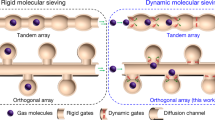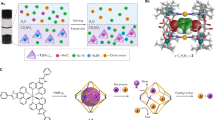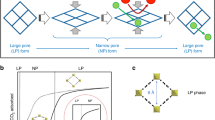Abstract
The energy-efficient separation of chemical feedstocks is a major sustainability challenge. Porous extended frameworks such as zeolites or metal–organic frameworks are one potential solution to this problem. Here, we show that organic molecules, rather than frameworks, can separate other organic molecules by size and shape. A molecular organic cage is shown to separate a common aromatic feedstock (mesitylene) from its structural isomer (4-ethyltoluene) with an unprecedented perfect specificity for the latter. This specificity stems from the structure of the intrinsically porous cage molecule, which is itself synthesized from a derivative of mesitylene. In other words, crystalline organic molecules are used to separate other organic molecules. The specificity is defined by the cage structure alone, so this solid-state ‘shape sorting’ is, uniquely, mirrored for cage molecules in solution. The behaviour can be understood from a combination of atomistic simulations for individual cage molecules and solid-state molecular dynamics simulations.
This is a preview of subscription content, access via your institution
Access options
Subscribe to this journal
Receive 12 print issues and online access
$259.00 per year
only $21.58 per issue
Buy this article
- Purchase on Springer Link
- Instant access to full article PDF
Prices may be subject to local taxes which are calculated during checkout






Similar content being viewed by others
References
Bloch, E. D. et al. Hydrocarbon separations in a metal–organic framework with open iron(II) coordination sites. Science 335, 1606–1610 (2012).
Alaerts, L. et al. Selective adsorption and separation of ortho-substituted alkylaromatics with the microporous aluminum terephthalate MIL-53. J. Am. Chem. Soc. 130, 14170–14178 (2008).
Alaerts, L. et al. Selective adsorption and separation of xylene isomers and ethylbenzene with the microporous vanadium(IV) terephthalate MIL-47. Angew. Chem. Int. Ed. 46, 4293–4297 (2007).
Alaerts, L., Maes, M., van der Veen, M. A., Jacobs, P. A. & De Vos, D. E. Metal–organic frameworks as high-potential adsorbents for liquid-phase separations of olefins, aklylnaphthalenes and dichlorobenzenes. Phys. Chem. Chem. Phys. 11, 2903–2911 (2009).
Maes, M. et al. Separation of C5-hydrocarbons on microporous materials: complementary performance of MOFs and zeolites. J. Am. Chem. Soc. 132, 2284–2292 (2010).
Vaidhyanathan, R. et al. A family of nanoporous materials based on an amino acid backbone. Angew. Chem. Int. Ed. 45, 6495–6499 (2006).
Nuzhdin, A. L., Dybtsev, D. N., Bryliakov, K. P., Talsi, E. P. & Fedin, V. P. Enantioselective chromatographic resolution and one-pot synthesis of enantiomerically pure sulfoxides over a homochiral Zn–organic framework. J. Am. Chem. Soc. 129, 12958–12959 (2007).
Kulprathipanja, S. & James, R. B. in Zeolites in Industrial Separation and Catalysis (ed. Kulprathipanja, S.) 173–202 (Wiley-VCH, 2010).
Li, J-R., Sculley, J. & Zhou, H. C. Metal–organic frameworks for separations. Chem. Rev. 112, 869–932 (2011).
Pedersen, C. J. The discovery of crown ethers. Angew. Chem. Int. Ed. Engl. 27, 1021–1027 (1988).
Tashiro, S., Kubota, R. & Shionoya, M. Metal–macrocycle framework (MMF): supramolecular nano-channel surfaces with shape sorting capability. J. Am. Chem. Soc. 134, 2461–2464 (2011).
Mastalerz, M. Shape-persistent organic cage compounds by dynamic covalent bond formation. Angew. Chem. Int. Ed. 49, 5042–5053 (2010).
Dube, H. & Rebek, J. Selective guest exchange in encapsulation complexes using light of different wavelengths. Angew. Chem. Int. Ed. 51, 3207–3210 (2012).
Tozawa, T. et al. Porous organic cages. Nature Mater. 8, 973–978 (2009).
Hasell, T. et al. Triply interlocked covalent organic cages. Nature Chem. 2, 750–755 (2010).
Ro, S., Rowan, S. J., Pease, A. R., Cram, D. J. & Stoddart, J. F. Dynamic hemicarcerands and hemicarceplexes Org. Lett. 2, 2411–2414 (2000).
Hasell, T., Schmidtmann, M., Stone, C. A., Smith, M. W. & Cooper, A. I. Reversible water uptake by a stable imine-based porous organic cage. Chem. Commun. 48, 4689–4691 (2012).
Jones, J. T. A. et al. Modular and predictable assembly of porous organic molecular crystals. Nature 474, 367–371 (2011).
Smith, W., Yong, C. W. & Rodger, P. W. DL_POLY: application to molecular simulation. Mol. Simul. 28, 385–471 (2002).
Brutschy, M., Schneider, M. W., Mastalerz, M. & Waldvogel, S. R. Porous organic cage compounds as highly potent affinity materials for sensing by quartz crystal microbalances. Adv. Mater. 24, 6049–6052 (2012).
Lydon, D. P., Campbell, N. L., Adams, D. J. & Cooper, A. I. Scalable synthesis for porous organic cages. Synth. Commun. 41, 2146–2151 (2011).
Mastalerz, M., Schneider, M. W., Oppel, I. M. & Presly, O. A salicylbisimine cage compound with high surface area and selective CO2/CH4 adsorption. Angew. Chem. Int. Ed. 50, 1046–1051 (2010).
Hasell, T., Chong, S. Y., Jelfs, K. E., Adams, D. J. & Cooper, A. I. Porous organic cage nanocrystals by solution mixing. J. Am. Chem. Soc. 134, 588–598 (2012).
Bushell, A. F. et al. Nanoporous organic polymer/cage composite membranes, Angew. Chem. Int. Ed. doi: http:dx.doi.org/10.1002/anie.20120633910.1002/anie.201206339 (2012).
Holden, D. et al. Bespoke force field for simulating the molecular dynamics of porous organic cages. J. Phys. Chem. C 116, 16639–16651 (2012).
Hoover, W. G. Canonical dynamics – equilibrium phase-space distributions. Phys. Rev. A 31, 1695–1697 (1985).
Forester, T. R. & Smith, W. SHAKE, rattle, and roll: efficient constraint algorithms for linked rigid bodies. J. Comput. Chem. 19, 102–111 (1998).
Acknowledgements
The authors acknowledge funding from the EPSRC (EP/H000925/1) and the Leverhulme Trust (F/00025/Al). A.C. is a Royal Society Wolfson award holder. The authors thank J.T.A. Jones for assistance with NMR measurements.
Author information
Authors and Affiliations
Contributions
A.C. conceived the project. T.M., D.A. and A.C. designed the experiments. T.M. prepared the cages and carried out the sorption experiments. K.J. conceived the modelling strategy and performed the molecular simulations. M.S. solved the single-crystal structures and S.C. refined the powder X-ray diffraction data. T.M. and A.A. performed the breakthrough experiments.
Corresponding author
Ethics declarations
Competing interests
The authors declare no competing financial interests.
Supplementary information
Supplementary information
Supplementary information (PDF 2052 kb)
Supplementary information
Supplementary movie 1 (WMV 4433 kb)
Supplementary information
Supplementary movie 2 (MOV 12923 kb)
Supplementary information
Supplementary movie 3 (MOV 24790 kb)
Supplementary information
Supplementary movie 4 (MOV 6705 kb)
Supplementary information
Crystallographic data for the complex between mesitylene and compound CC3 (CIF 56 kb)
Supplementary information
Crystallographic data for the complex between meta-xylene and compound CC3 (CIF 88 kb)
Supplementary information
Crystallographic data for the complex between para-xylene and compound CC3 at 100K (CIF 42 kb)
Supplementary information
Crystallographic data for the complex between para-xylene and compound CC3 at 295K (CIF 41 kb)
Rights and permissions
About this article
Cite this article
Mitra, T., Jelfs, K., Schmidtmann, M. et al. Molecular shape sorting using molecular organic cages. Nature Chem 5, 276–281 (2013). https://doi.org/10.1038/nchem.1550
Received:
Accepted:
Published:
Issue Date:
DOI: https://doi.org/10.1038/nchem.1550
This article is cited by
-
An Allochroic Molecular Cage Switch for Sensing and Capturing Organic Pollutants
Chemical Research in Chinese Universities (2023)
-
One-step removal of alkynes and propadiene from cracking gases using a multi-functional molecular separator
Nature Communications (2022)
-
Solvent-controlled self-assembly of tetrapodal [4 + 4] phosphate organic molecular cage
Scientific Reports (2020)
-
Efficient separation of xylene isomers by a guest-responsive metal–organic framework with rotational anionic sites
Nature Communications (2020)
-
A hydroxyl-functionalized homochiral porous organic cage for gas chromatographic separations
Microchimica Acta (2020)



